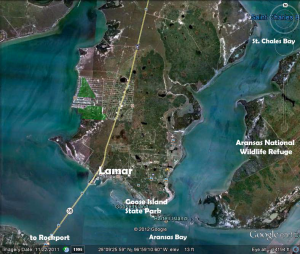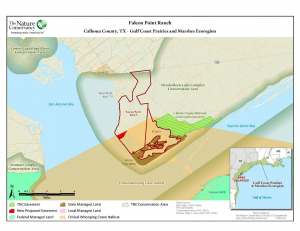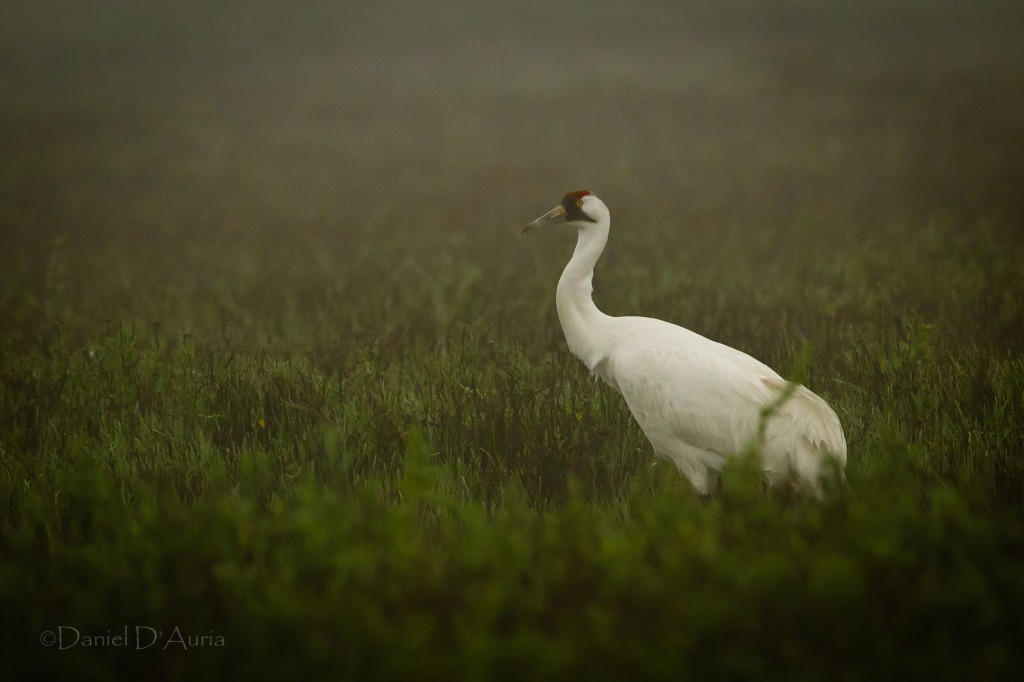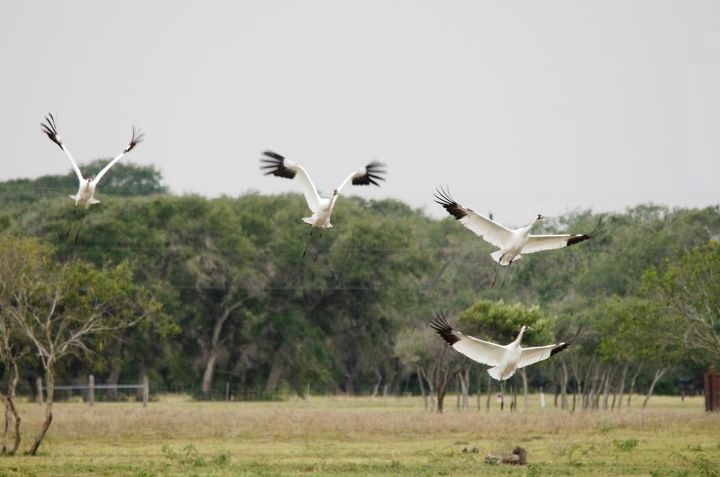Archive for the ‘Association News’ Category
Lobstick Whooping Crane Feared Shot In South Dakota
June 7, 2012Article from Northern Journal, Fort Smith, NT Canada (www.srj.ca).
By CHRIS TALBOT, Northern Journal Reporter, • Tue, Jun 05, 2012
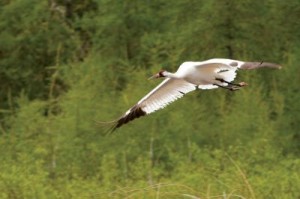
Fort Smith local Ronnie Schaefer believes the whooping crane (like the one pictured here) shot in South Dakota was one of the famous Lobstick pair. (Photo: Klaus Nigge)
A whooping crane recently shot in South Dakota may be one of the famous Lobstick cranes that nest north of Wood Buffalo National Park, according to a Fort Smith man. Ronnie Schaefer, who has observed the cranes for many years, told Northern Journal he believes the crane shot en route to Canada is one of the Lobstick pair. The pair has made the Fox Hole prairie on Salt River First Nation land home for 19 years, usually arriving in the first two weeks of May. They have not arrived yet.
Another reason Schaefer believes it may be one of the Lobstick birds is because they are not tagged. Although not confirmed, it is believed by Parks Canada that the crane shot in South Dakota was likewise not tagged. Schaefer said he is trying to clarify that, but so far, the U.S. Fish and Wildlife Service (FWS), which is investigating the shooting, has been tight-lipped about the case.
Brad Merrill, a spokesperson for FWS Mountain-Prairie Region, said it is FWS policy not to discuss cases still under investigation. He did confirm that the crane was travelling with another adult and a juvenile, both of which were seen in the same corn field where the shooting occurred. What happened to the other cranes is unknown.
“It’s a big loss for us because they’re a recognized pair from here to Aransas,” Schaefer said.
The Fox Hole prairie is the traditional nesting ground for another pair of whooping cranes, which Schaefer said has already arrived and settled in. A new nesting pair has also settled in the area, but Schaefer noted it is not the Lobstick pair.
Others believe it is too early to tell for sure if the killed bird was indeed one of the famous cranes.
“That would be really tough to deduce based on what we know,” Dan Alonzo, refuge manager at Aransas National Wildlife Refuge, told The Journal.
Chester McConnell, trustee emeritus at the Whooping Crane Conservation Association, told The Journal it would be a great loss should the shot crane be one of the Lobstick pair.
“It would be, but I’m not certain (Schaefer) would be correct on that. I don’t know what information he has, but the cranes haven’t been long settling in and some of them would take a little while to settle into nesting,” McConnell said.
According to McConnell, whooping cranes do not all fly in and start building nests right away. Though their time to nest is short, they are known to “fool around.”
With only about 300 whooping cranes migrating between Wood Buffalo National Park and Aransas National Wildlife Refuge in Texas, the loss of any of the endangered birds is significant, Alonzo said. There are approximately 500 whooping cranes left in the world.
“It would be the equivalent to the loss of any other bird,” Alonzo said. “Any loss is significant. We want to do anything to deter that. The Lobstick or any other pair is just as important.”
One death of many
The shooting of the whooping crane in South Dakota is the latest in a dozen confirmed shootings of the species since 1951. Approximately 80 whooping cranes of the western migratory flock have also gone missing during that time, their fates unknown, McConnell said.
Cranes that do not die of natural causes are most likely to be killed flying into power lines or electrified fences, he said, but some people shoot the birds out of malice.
The eastern migratory and non-migratory Louisiana populations suffer even more from human predation. McConnell noted 11 cranes in the eastern and Louisiana populations have been shot in the last two years. Many of those cases are still unsolved. The most recent incident prior to the April 20 shooting in South Dakota was the January 2012 shooting of a male whooping crane in Knox County, Indiana. The crane was spotlighted and shot, according to FWS. Charges are pending against two men in their early twenties.
————————————————————————————————————————
The Whooping Crane Conservation Association has established a REWARD fund to raise $10,000 for conviction of the killer of the whooping crane in South Dakota on May 20, 2012. Donations are still needed. Click on the following link to read details of the Reward fund and how you can help: https://whoopingcrane.com/whooping-crane-shot-10000-reward/
Critical Whooping Crane Wintering Grounds Purchased
June 2, 2012by Whooping Crane Conservation Association
Endangered whooping cranes now have an additional 278 acres of habitat on which they can live during winter. The 278 acres involved two critical habitat acquisition projects for North America’s last wild flock of migratory whooping cranes. In one project, three conservation groups partnered to purchase the privately-owned 178 acres in Holiday Beach area north of Rockport, Texas. Sale of the property closed last week. The endangered whooping crane flock spends the winter in the area and some have often been observed on this property. This important property purchase was coordinated by Coastal Bend Bays & Estuaries Program, Whooping Crane Conservation Association and Texas Parks and Wildlife Department.
Whooping Crane Conservation Association President Lorne Scott explained that wintering habitat in Texas is more confined and threatened than the Canadian breeding grounds. He also said, “The wintering habitat is so scarce and so unavailable, anything that does come up for sale and has potential, we try to secure it.”
Scott stated that the whooping crane has become a symbol of wildlife conservation in North America. He counseled that, “The whooping crane saga has shown that after decades of work and partnerships, we can save a species and work for conservation.” Scott believes, “We have an obligation to make every effort to secure all our native flora and fauna.”
Coastal Bend Bays & Estuaries Program received the funds for the important 178 acre purchase through the U.S. Fish and Wildlife Service’s Endangered Species Recovery Land Acquisition Grant Program, administered by the Texas Parks and Wildlife Department. Matching funds were provided by the Whooping Crane Conservation Association. The Nature Conservancy assisted in the property purchase. CBBEP property manager Jake Herring said “The acquisition of this property is important to CBBEP because it is occupied whooping crane habitat.”
In a second project, The Nature Conservancy made known the protection of more than 100 additional acres of whooping crane winter habitat. With funding assistance from Whooping Crane Conservation Association and U.S. Fish and Wildlife Service, the Conservancy purchased a conservation easement on Falcon Point Ranch in Calhoun County, Texas. The Conservancy purchased the conservation easement for $605,000 with funding from the United States Fish and Wildlife Service, a $200,000 grant from the Whooping Crane Conservation Association and funds from private donors and foundations.
Falcon Point Ranch is located in a coastal region known as Welder Flats.
Whooping crane habitat Falcon Point Ranch, Texas
Today scientists estimate that at least 10 percent of the remaining flock (approximately 25 – 30 birds) winters here. The topography of the property and its waterfront views on San Antonio Bay made it a prime target for development.
“The owners of Falcon Point Ranch have been working to conserve this property for more than five years,” said Bill Ball a representative of the ranch. “It is very exciting to see this important project come to fruition and to know that this truly special place will be protected.”
Ecologists worried that the development of the ranch would not only compromise important habitat on the property, it would compromise surrounding conservation lands as well, including properties the Natural Resources Conservation Service (NRCS) division of the USDA has protected within the last three years.
“NRCS is proud to be a part of this regional effort to protect and restore vital Texas wetlands, for not just the incredibly rare whooping crane but all wetland wildlife species,” said Claude Ross, NRCS Program Manager. “Working with the local landowners, NRCS has worked to protect and restore more than 11,000 acres of habitat in Welder Flats. The Nature Conservancy’s easement on Falcon Point Ranch will help safeguard those investments.”
“Limited and threatened wintering habitat on the Gulf Coast is one of the greatest challenges facing North America’s tallest birds, said Lorne Scott, president of Whooping Crane Conservation Association. “The WCCA congratulates The Nature Conservancy for leading efforts in securing the Falcon Point Ranch.”
The whooping crane population, which breeds in Canada and then migrates 2,400 miles south to the Texas Gulf Coast, declined from an estimated 1500 to just 15 birds between 1850 and 1945. Since then, cooperative conservation efforts between the U.S. and Canada have increased the population twentyfold. Today there are an estimated 300 wild cranes in North America that migrate between Aransas National Wildlife Refuge in Texas to Wood Buffalo National Park, Canada.
“North America all but lost one of its most iconic species,” said Laura Huffman, state director of The Nature Conservancy in Texas. “Although the whooping crane is slowly rebounding, it is still a precarious situation given our state’s growing water challenges and projected growth. If we want our children and grandchildren to experience this majestic creature, conservation efforts to safeguard its habitat aren’t just important, they are absolutely essential.”
The properties now-protected by these two projects will provide important additional winter habitat for the endangered whooping cranes.
Whooping Crane Killing – One Investigation Completed–More to Go
May 17, 2012Reported by: Whooping Crane Conservation Association
Indiana Conservation Officers, with assistance from U.S. Fish & Wildlife Service agents, have completed an investigation into the killing of a male whooping crane in early January 2012 in Knox County, Indiana.
The Knox County Prosecutor is reviewing the case, and charges are pending against Jason R. McCarter, 21, of Wheatland, and John C. Burke, 23, of Monroe City.
According to the case report filed with the prosecutor, ICO Joe Haywood received information in mid-January that a whooping crane had been spotlighted at night and shot and killed with a high-powered rifle.
The ensuing investigation involved multiple law enforcement agencies, wildlife biologists and private individuals and provided information that identified the suspects and also linked the bird to a federal program to reintroduce whooping cranes in the eastern United States.
Whooping cranes are an endangered species protected by both state and federal laws. Efforts to save whooping cranes began after their nationwide population dwindled to 15 birds in 1941, according to the Whooping Crane Conservation Association.
The Association advises there are approximately 600 whooping cranes in existence, with approximately 445 in the wild. Approximately 300 are in the original western flock that migrates between Aransas NWR, Texas and Wood Buffalo National Park, Canada. Also more than 100 are in the eastern reintroduction flock that travels through Indiana on a migratory path between Wisconsin and Florida. Roughly 150 captive-raised birds are used in the reintroduction programs at a cost exceeding $100,000 per bird.
The whooping crane shot in Knox County, Indiana was part of a nesting pair that was taught its migratory path by ultra-light aircraft. For more on the bird, see: www.learner.org/jnorth/tm/crane/08/BandingCodes827.html
An investigation into the killing of a second whooping crane in Jackson County, Indiana continues. Anyone with information can call the Turn In A Poacher hotline at 1-800-TIP-IDNR.
The Whooping Crane Conservation Association reminds the public that the Indiana case is just one of four cases. Three more whooping crane killing cases are still under investigation. One case is in South Dakota, one in Indiana and one in Alabama.
The whooping crane killed in South Dakota on April 20, was a member of the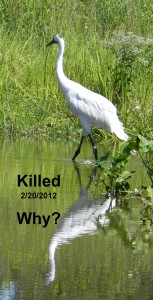 original wild western flock. The migrating adult bird was traveling with two additional whooping cranes before being shot with a high-power rifle as it was standing in a corn field. The Whooping Crane Conservation Association will pay a reward not to exceed $10,000 to anyone who provides information which leads to the conviction of any individuals responsible for the killing of the whooping crane which took place on the afternoon of Friday, April 20, 2012 along 354th Avenue, approximately 17 miles southwest of Miller, South Dakota.
original wild western flock. The migrating adult bird was traveling with two additional whooping cranes before being shot with a high-power rifle as it was standing in a corn field. The Whooping Crane Conservation Association will pay a reward not to exceed $10,000 to anyone who provides information which leads to the conviction of any individuals responsible for the killing of the whooping crane which took place on the afternoon of Friday, April 20, 2012 along 354th Avenue, approximately 17 miles southwest of Miller, South Dakota.
The purpose of all rewards is to encourage the public to share information they might have about criminal activities involving whooping cranes. Federal, State, Provincial, and other public law enforcement personnel, and criminal accomplices who turn “states” evidence to avoid prosecution, shall not be eligible for this reward. If more than one informant is key to solving a specific case, the reward will be equally divided between the informants.
Anyone with information should call either the 24-hour “Turn in a Poacher Hotline” at 1-888-OVERBAG (683-7224) or the U.S. Fish & Wildlife Service at 605-224-9045 to report any information which will aid officers in the apprehension of the shooter. Callers can remain anonymous.
Eleven whooping cranes of the experimental Eastern Migratory population and non-migratory Louisiana population have been shot in the last two years. The Alabama case of January 2011 is still active. The Louisiana shootings have been solved by State Law Enforcement personnel and a reward will not be involved. One case is still active in Indiana. In Indiana the State has offered $2,500, the Fish and Wildlife Service $2,500 and the Humane Society $2,500 in reward.
Donations (which are tax-deductible) are being requested for the Whooping Crane Conservation Association’s Reward Account. The public is encouraged to donate to this fund. Donations should be mailed to Whooping Crane Conservation Association, 2139 Kennedy Avenue, Loveland, CO, USA 80538 or to donate by credit card click on the link: https://whoopingcrane.com/whooping-crane-shot-10000-reward/
All Whooping Cranes Migrating To Canada
April 27, 2012- By: Chester McConnell, Whooping Crane Conservation Association
Whooping Crane Shot – $10,000 Reward
April 24, 2012by Chester McConnell, Whooping Crane Conservation Association
The Whooping Crane Conservation Association will pay a reward not to exceed $10,000 to anyone who provides information which leads to the conviction of any individuals responsible for the killing of a whooping crane which took place on the afternoon of Friday, April 20, 2012 along 354th Avenue, approximately 17 miles southwest of Miller, S.D. The purpose of the reward is to encourage the public to share information they might have about criminal activities involving whooping cranes. Federal, State, Provincial, and other public law enforcement personnel, and criminal accomplices who turn “states” evidence to avoid prosecution, shall not be eligible for this reward. If more than one informant is key to solving a specific case, the reward will be equally divided between the informants. 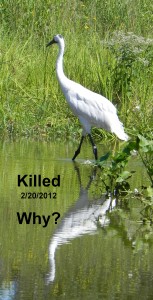
A reward has also been offered by the U.S. Fish and Wildlife Service for information leading to the arrest and conviction of the person responsible for the shooting of the whooping crane. Law enforcement officers from the Service and the South Dakota Game, Fish and Parks are investigating the shooting, which took place on the afternoon of Friday, April 20, 2012. The migrating adult whooping crane was traveling with two additional whooping cranes before being shot with a high-power rifle as it was standing in a corn field.
Anyone with information should call either the 24-hour “Turn in a Poacher Hotline” at 1-888-OVERBAG (683-7224) or the U.S. Fish & Wildlife Service at 605-224-9045 to report any information which will aid officers in the apprehension of the shooter. Callers can remain anonymous.
Eleven whooping cranes of the experimental Eastern Migratory population and non-migratory Louisiana population have been shot in the last two years. The Alabama case of January, a year ago, is still active. The Louisiana shootings have been solved by State Law Enforcement personnel and a reward will not be involved. One case is still active in Indiana. In Indiana the State has offered $2,500, the Fish and Wildlife Service $2,500 and the Humane Society $2,500 in reward.
Donations (which are tax-deductible) are being requested for the Whooping Crane Conservation Association’s Reward Account.
Donations should be mailed to Whooping Crane Conservation Association, 2139 Kennedy Avenue, Loveland, CO, USA 80538 or to donate by credit card click on the button below…
Thank You
Four Whooping Crane Flocks Thriving
April 21, 2012By: Chester McConnell, Whooping Crane Conservation Association
Western Whooping Crane Flock
“Only 5 whooping cranes remain on Aransas National Wildlife Refuge as of April 21” according to Dan Alonso, Refuge Manager. All others have begun their migration towards their nesting grounds at Wood Buffalo National Park, Canada. “Only 3 of the 29 whooping cranes carrying GPS transmitters remained on the refuge this past week” said Brad Strobel, Aransas Refuge biologist. Further north on the whooper migration route, Martha Tacha, U.S. Fish and Wildlife Service, reports that, “most of the cranes with GPS transmitters have now passed southern Nebraska and are continuing on their migration north. The cranes are currently distributed from northern Texas to northwestern Saskatchewan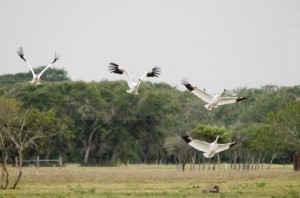 with some being within three days flying time of their Canadian nesting grounds. Some of the migrating whoopers were probably slowed last weekend due to the extensive strong storms from Oklahoma through South Dakota.”
with some being within three days flying time of their Canadian nesting grounds. Some of the migrating whoopers were probably slowed last weekend due to the extensive strong storms from Oklahoma through South Dakota.”
Further north on the migration route, wildlife technician Lea Craig-Moore, Canadian Wildlife Services reports that, “Whooping crane migration is in full swing in the Saskatchewan area.” She advised, “We have had the first flush of arrivals in the province and have birds spread from the SE prairie to the NW boreal. Family groups have been seen in a number of locations. Young cranes are learning the preferred stopover sites from their parents as they migrate.”
Eastern Whooping Crane Flock
Most of the whooping cranes in the eastern experimental flock have now reached their Wisconsin nesting area. Wisconsin Department of Natural Resources pilot Bev Paulan conducted an aerial survey April 17th and reported that there are currently 10 active nests located in the core reintroduction area in Wisconsin. Three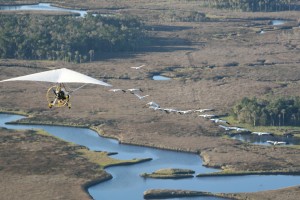 nests were abandoned earlier. Ten more pairs could possibly nest. Heather Ray, Operation Migration advises that “Hopes are high for baby chicks!”
nests were abandoned earlier. Ten more pairs could possibly nest. Heather Ray, Operation Migration advises that “Hopes are high for baby chicks!”
For several weeks, there has been much interest on the 9 young whooping cranes led south by Operation Migration ultralight planes to Alabama. Due, in part to government regulations, the young birds were finally placed on Wheeler National Wildlife Refuge in Alabama to spend the winter. On April 12 the 9 departed Alabama together on their first unaided journey north. They split into two or more groups during migration, and may be back in Wisconsin as you read this. Not quite a year old, the cranes are too young to pair up or breed. They will wander around the Wisconsin area nesting area and learn how to be whooping cranes.
Louisiana Non-Migratory Flock of Whooping Cranes
On December 1, 2011, a second cohort of juvenile whooping cranes was shipped to Louisiana from the Patuxent Wildlife Research Center. As with the first cohort, the 16 new birds (7 males, 9 females) were initially held in the top‐netted pen. Permanent bands and transmitters were attached to their legs on 8‐9 December and the birds were released into the open pen on 27 December.
On 31 December L4‐10, a survivor from the first cohort, returned to the pen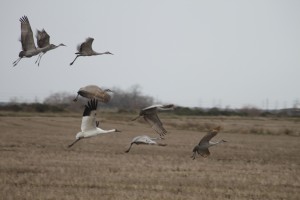 site and joined the 16 chicks. He had spent almost all summer and fall in the marsh just west of the release area and therefore had the strongest ties to the area. The 16 juveniles initially attempted to chase him away and while they continue to keep him away from the food shelter and the feeders they generally became more tolerant of his presence. Food continued to be provided for the birds in the open pen but will soon be discontinued.
site and joined the 16 chicks. He had spent almost all summer and fall in the marsh just west of the release area and therefore had the strongest ties to the area. The 16 juveniles initially attempted to chase him away and while they continue to keep him away from the food shelter and the feeders they generally became more tolerant of his presence. Food continued to be provided for the birds in the open pen but will soon be discontinued.
The young whoopers have shown a similar pattern of movement and pen use to the previous cohort – roosting outside the pen at night but using the pen during the day, primarily in the afternoons. However, with more water across the marsh this group of birds is beginning to range further away from the pen and use areas on the east side of the property which the first cohort did not use.
Florida Non-migratory Flock of Whooping Cranes
Marty Folk, Florida Fish and Wildlife Conservation Commission reports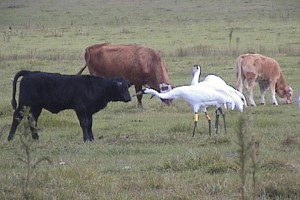 that, “As of 1 February 2012 we estimated there were 19 whooping cranes in the Florida resident population (8 males, 11 females) including 7 pairs. Again, this year, we will study the nesting ecology of these whooping cranes and Florida sandhill cranes. The goals are to determine causes of nest failure, compare the incubation behavior of the 2 species, and determine the efficacy of several research tools for these purposes. The nesting season has begun with our first sandhill crane nest just discovered in Polk County. Drought continues to plague Florida’s wetlands. The northern range of these cranes is very dry and unlikely to support much crane nesting. Fortunately, further south, we have some water for nesting.”
that, “As of 1 February 2012 we estimated there were 19 whooping cranes in the Florida resident population (8 males, 11 females) including 7 pairs. Again, this year, we will study the nesting ecology of these whooping cranes and Florida sandhill cranes. The goals are to determine causes of nest failure, compare the incubation behavior of the 2 species, and determine the efficacy of several research tools for these purposes. The nesting season has begun with our first sandhill crane nest just discovered in Polk County. Drought continues to plague Florida’s wetlands. The northern range of these cranes is very dry and unlikely to support much crane nesting. Fortunately, further south, we have some water for nesting.”
Whooping Cranes Begin Migration to Canada
April 12, 2012An estimated 115 whooping cranes remain on, or near the Aransas National Wildlife Refuge in Texas according the U.S. Fish and Wildlife Service. Aransas Refuge officials report that, “Data from GPS-marked whooping cranes also indicates many of the birds have begun their migration. Approximately two thirds of the marked birds have left the Texas coast. Departure dates for those cranes in migration range between the 5th of March and 10th of April with 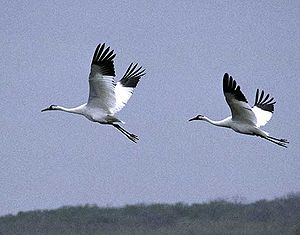 an average departure date of 29 March. To date, none of the marked birds have arrived at Wood-Buffalo National Park. We continue to download data from the radio-marked birds, as well as receive information from actual sightings.”
an average departure date of 29 March. To date, none of the marked birds have arrived at Wood-Buffalo National Park. We continue to download data from the radio-marked birds, as well as receive information from actual sightings.”
Reports of whooping crane sightings made to the Whooping Crane Conservation Association indicate migrating birds are in every U.S. state and Canada along the migration route. The migration appears to be earlier this year and may be due to the warmer weather. Hopefully the nesting grounds at Wood Buffalo National Park, Canada will be in suitable condition when the whoopers arrive there. here.
For those whoopers currently remaining on Aransas Refuge, habitat conditions appear to be improving. Aransas personnel report that, “As of April 11, the monthly precipitation totals for Aransas National Wildlife Refuge are 1.19 inches. Salinity levels in San Antonio Bay continue to remain under 20 parts per thousand (ppt) and are currently recorded at 16.5 ppt. Increased precipitation and fresh water inflows from Central Texas are helping to improve conditions in the marsh but the refuge is still not to pre-drought conditions.”
Aransas Whooping Crane Update – 196 birds
March 15, 2012by: Chester McConnell, Whooping Crane Conservation Association
It appears that we may never know if the Aransas – Wood Buffalo population of whooping cranes reached the hoped for 300 birds during 2011 – 2012. The weather has been a large factor. First, an unknown number of whoopers cranes did not arrive at Aransas National Wildlife Refuge. Then some traveled around in Texas counties near Aransas Refuge while others spent the winter in Kansas and Nebraska. And weather had a crippling effect on attempts to count the whoopers that did winter on Aransas Refuge.
According to Aransas personnel, “High winds and low cloud cover impeded the census flights scheduled during late February, allowing for only two of the three scheduled census flights. Those flights were conducted on February 25 and 26, 2012. Peliminary data analyses indicated the population of cranes within the surveyed area was 196. Although lower than the previous 245 estimate, the difference is not statistically significant and most likely the result of limited flying time. Also, this number does not reflect whooping cranes outside the survey area, including those that have dispersed.
Radio-marked birds and sightings of whooping cranes from the flyway indicate the birds have begun their northern migration back to Wood Buffalo National Park in the Northwest Territories of Canada where they nest exclusively. Some biologist believe that this earlier than usual northern migration is also due to the unseasonal warm weather. Depending on the weather, biologists hope to conduct another census flight before the end of the month.
Refuge officials also issued an update on the status of whooping cranes that died during the past several months. A report from the first whooper carcass (recovered Dec. 7, 2011) was issued from the National Wildlife Health Center (NWHC) and it indicates the bird had a systemic blood infection. This type of systemic infection has been known to cause death. The refuge is still waiting on the final report from the second carcass (recovered January 18, 2012). A third carcass of a radio-collared bird was recovered (Feb. 29, 2012) and sent to the NWHC in Madison, WI last week for necropsy.
Some good weather news relating to the whoopers is that, as of March 14, the monthly precipitation totals for Aransas National Wildlife Refuge are .85 inches and salinity levels in San Antonio Bay are recorded as 19.7 parts per thousand. With salinity levels below 20 parts per thousand, conditions in the marsh are normalizing and food production for the birds improving. Even so, the refuge is still not to pre-drought conditions and biologists remain concerned.
Since the last Aransas Refuge update, the refuge conducted an additional prescribed burn, raising the winter’s total to 12,310 acres of habitat. The refuge’s fire program hopes to conduct a final burn in the next few weeks on Matagorda Island but the changing weather makes it uncertain. Despite one burn remaining, all of the burns planned in areas whooping cranes would likely use have been completed and were successful.
Whooping Cranes on Aransas and Private Lands
March 1, 2012Whooping crane aerial census surveys were completed a second time on Aransas Refuge in February. But analysis of the information is not yet complete. According to refuge officials the February aerial survey has had some challenges due to weather but they are continuing their efforts. The updated census information will be posted on the website as soon as it becomes available. Meanwhile the interested public must rely on the January survey information that indicated the population of cranes to be 245 individuals. Aransas officials caution that this number does not reflect whooping cranes outside the survey area, including those that have dispersed. Whooping crane biologist and many thousands of whooper followers have been hoping for a total population count of 300 this year.
The unusual warm weather and extreme drought conditions in Texas are believed to be a primary cause for the dispersal of whooping cranes this year. Normally the birds remain mostly on Aransas National Wildlife Refuge during winter months with a few moving to nearby suitable locations. This year, however the whoopers are ranging further out from the refuge with some as far north as Nebraska. Citizen observation reports made to the Whooping Crane Conservation Association detected whoopers in Nebraska, Kansas, Oklahoma and eight counties in Texas.
- Figure 1. Whooping cranesmaking use on private land in Texas.
Some good news is that, as of February 29, the precipitation totals for Aransas, TX are 3.75 inches. Also, heavy rains north of the Aransas Refuge brought much fresh water downstream to the bays and estuaries near the refuge. Salinity levels in San Antonio Bay are recorded as 20.4 parts per thousand. Salinity levels have dropped due to recent freshwater inflows from rain in Central Texas, as well as localized rainfall.
Since the last Aransas Refuge update, the refuge has conducted additional prescribed burns bringing the total to 10,852 acres of habitat. The whooping cranes have been observed eating the roasted acorns and other food sources. There are still approximately 1,110 acres planned for the remaining whooping crane season. The refuge had originally hoped to burn approximately 14,200 acres but weather conditions prevented firefighters from safely and effectively conducting the prescribed burns to help alleviate low food sources for the cranes.
Aransas Refuge Estimates 245 Whooping Cranes
February 17, 2012By Chester McConnell, WCCA
Aransas National Wildlife Refuge biologists now estimate the population of whooping cranes to be approximately 245 individuals within their survey area. This number does not include whoopers known to be in at least five other Texas counties and other states. Some of the birds are moving around off the refuge for reasons not fully understood. It is believed that the whoopers may be seeking additional food sources. The refuge’s January 2012 survey consisted of three flights conducted on January 26, 27, and 29th. Survey biologists searched Matagorda Island, San Jose Island, Blackjack Peninsula, Lamar Peninsula, Dewberry Island and Welder Flats. A second round of survey flights will take place in mid to late February.
Biologists are receiving many reports of whooping cranes outside the survey area in the following Texas counties: Matagorda, Refugio, Calhoun, Aransas, Williamson, San Patricio, Maverick, and Caldwell. Whooping cranes of the Aransas-Wood Buffalo population are also currently residing in other states as far north as Nebraska. These cranes are naturally supplementing their own food sources by wintering around freshwater lakes and other marshes.
Refuge personnel continue to help alleviate low food resources by doing more prescribed burns. This winter they have burned 8,095 acres of habitat. Whooping cranes have been observed eating the roasted acorns and other food sources in burned areas. An additional 6,129 acres are planned to be burned while whooping crane remain on their winter habitat
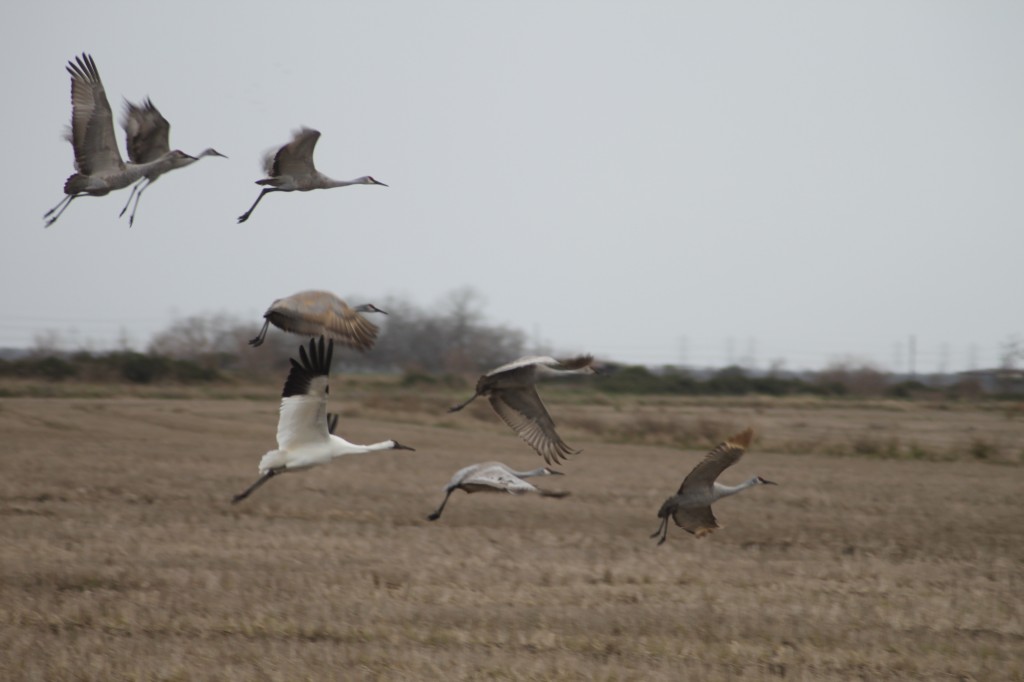
- Whooping crane with sandhill cranes in Texas rice field. Photo by Leanne Sliva
Fortunately some rains have fallen of Aransas Refuge recently. The first two weeks of February produced a total of 1.89 inches of rain. Water salinity levels have dropped due to recent freshwater inflows from rain in Central Texas, as well as localized rainfall. Salinity levels in San Antonio Bay are currently recorded as 19.9 parts per thousand. Salinity levels in surrounding bays still remain higher than normal which forces whooping cranes to expend more energy flying to fresh water sources.
Methods of counting whooping cranes on Aransas Refuge have been modified. Refuge official, Vicki Muller explained: “In previous years, the refuge gauged the whooping crane population by counting individual birds within the survey area. The aerial surveys objective was focused on counting every individual bird regardless of where they were located within the survey area. This technique is no longer feasible because the population is increasing. Biologists are flying along a transect, straight lines set at specific distances within the survey area. Previously each survey consisted of a single flight; now one survey includes three flights on three separate days (weather permitting) within a preset timeframe. The birds counted represent an estimate of the population within the surveyed area. It is expected that some birds will be not be included in the count, but this method (known as Distance Sampling) is commonly used to determine rare and endangered wildlife populations, including fin whales, Karner blue butterflies, and raptors.”
Aransas officials explain that, “Over the years the whooping crane population has been growing, the habitat changing, and the birds naturally dispersing. The primary goal is to ensure the recovery of the species and to do that the refuge and its partners must adjust with the ever-changing conditions. In 2009, biologists began putting radio telemetry bands on the cranes. Using leg snares, and other trapping techniques, the birds are captured and equipped with GPS leg bands. This technology records birds locations and allows biologists to learn which habitats they are using, where they stop during their migration, and much more. This technology is extremely valuable but it will be several years before sufficient data from the individual birds can be collected and fully analyzed. It will take a considerable more amount of time before the data will reflect patterns of the population as a whole. To date, the refuge and its partners are tracking approximately 30 whooping cranes with leg bands.”
